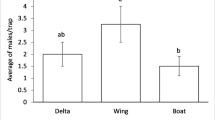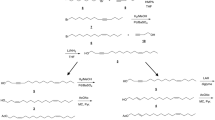Abstract
The aim of this investigation was to clarify whether pheromone traps could provide a reliable tool for early detection of aS. littoralis adult population and for indicating infestation by its larvae in the field. The aggregated pattern of distribution of adults is indicated by the fit of data to Taylor’s Power Law or to the negative binomial distribution. However, the relatively high k values obtained indicate thatS. littoralis adults are only slightly aggregated and sometimes almost randomly distributed. Trap position in the field and number of traps per area unit affected size of catches in both female-baited and synthetic-pheromone-baited traps. No relationship between size of catches and temperature, wind velocity or moon phase was detected. Variations in size of catches among traps was not affected much by the baited females. Pheromone traps proved to be a reliable tool for estimating fluctuations in population density and for indicating adult peaks. However, no correlation between male catches and infestation by larvae in the experimental plots was found. Pheromone traps may serve only as a warning device indicating the possibility of potential attack due to an increase in adult population level. Mercury vapor light traps were inferior to pheromone traps in detecting changes inS. littoralis population densities. Synthetic pheromone (“Litlure”) was somewhat less efficient in attracting males than virgin females; however, it is suitable for detecting fluctuations in theS. littoralis adult population.
Similar content being viewed by others
References
Avidov, Z. andHarpaz, I. (1969) Plant Pests of Israel. Israel Universities Press, Jerusalem.
Bliss, C.I. andOwen, A.R.G. (1958) Negative binomial distribution with a common k.Biometrika 45: 37–58.
Brown, E.S., Betts, E. andRainey, R.C. (1969) Seasonal changes in distribution of the African army wormSpodoptera exempta (Wlk.) (Lep., Noctuidae) with special reference to Eastern Africa.Bull. ent. Res. 58: 661–728.
Campion, D.G. (1972) Some observations on the use of pheromone traps as a survey tool forSpodoptera littoralis. Misc. Rep. Centre for Overseas Pest Research 4.
Campion, D.G., Bettany, B.W., Nesbitt, B.F., Beevor, P.S., Lester, R. andPoppi, R.G. (1974) Field studies of the female sex pheromone of the cotton leaf wormSpodoptera littoralis (Boisd.) in Cyprus.Bull. ent. Res. 64: 89–96.
Campion, D.G., Bettany, B.W. andSteedman, R.A. (1974) The arrival of male moths of the cotton leaf-wormSpodoptera littoralis (Boisd.) (Lepidoptera, Noctuidae) at a new continuously recording pheromone trap.Bull. ent. Res. 64: 379–386.
Jacobson, M. (1966) Chemical insect attractants and repellents.A. Rev. Ent. 11: 403–422.
Miyashita, K., Nakamura, K. andIto, I. (1972) The rate of catch of the male ofSpodoptera litura F. (Lepidoptera: Noctuidae) by virgin female traps.Appl. Ent. Zool. 7: 109–115.
Moore, I. andNavon, A. (1973) A new gelling technique and improved calcium alginate medium for rearingSpodoptera littoralis. J. econ. Ent. 66: 563–566.
Nesbitt, B.E., Beevor, P.S., Cole, R.A., Lester, R. andPoppi, R.G. (1973) Sex pheromones of two Noctuid moths.Nature (New Biology) 244: 208–209.
Neumark, S., Jacobson, M. andTeich, I. (1974) Field evaluation of the four synthetic components of the sex pheromone ofSpodoptera littoralis and their improvement with an antioxidant.Environ. Lett. 6: 219–230.
Shorey, H.H. (1973) Behavioral responses to insect pheromones.A. Rev. Ent. 18: 349–380.
Shorey, H.H. (1974) Environmental and physiological control of insect sex pheromone behaviour,in:Birch, M.C. (Ed.) Pheromones. North Holland Publishing Co., Amsterdam, pp. 62–80.
Southwood, T.R.E. (1966) Ecological Methods. Methuen and Co. Ltd., London.
Stern, V.M. (1973) Economic threshold.A. Rev. Ent. 18: 259–280.
Tamaki, Y., Noguchi, H. andYushima, T. (1973) Sex pheromonesof Spodoptera litura F. (Lepidoptera: Noctuidae): Isolation, identification and synthesis.Appl. Ent. Zool. 8: 200–203.
Tamaki, Y. andYushima, T. (1974) Sex pheromones of the cotton leafwormSpodoptera littoralis. J. Insect Physiol. 20: 1005–1014.
Taylor, L.R. (1965) A natural law for the spatial disposition of insects.Proc. XII Int. Congr. Ent. pp. 396–397.
Tette, P.J. (1974) Pheromones in insect population management,in:Birch, M.C. (Ed.) Pheromones. North Holland Publishing Co., Amsterdam, pp. 399–410.
Waters, W.E. (1959) A quantitative measure of aggregation in insects.J. econ. Ent. 52: 1180–1184.
Yathom, S. (1971) Distribution and flight period of Amphipyrinae (Noctuidae: Lepidoptera) species in Israel in 1959–1970.Israel J. Ent. 6: 107–132.
Yushima, T., Noguchi, H. andTamaki, Y. (1973) Mating and sex pheromone ofSpodoptera litura F. (Lepidoptera: Noctuidae): An introductory report.Appl. Ent. Zool. 8: 18–26.
Yushima, T. andTamaki, Y. (1974) Field evaluation of a synthetic sex pheromone, “Litlure”, as an attractant for males ofSpodoptera litura F. (Lepidoptera: Noctuidae).Appl. Ent. Zool. 9: 147–152.
Author information
Authors and Affiliations
Rights and permissions
About this article
Cite this article
Kehat, M., Genizi, A. & Greenberg, S. The use of traps baited with live females or synthetic pheromone as a tool for improving control programs of the cotton leaf-worm,Spodoptera littoralis (Boisd.), in cotton fields in israel. Phytoparasitica 3, 3–18 (1975). https://doi.org/10.1007/BF02981216
Received:
Accepted:
Issue Date:
DOI: https://doi.org/10.1007/BF02981216




